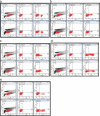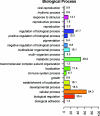Immunological profiles of Bos taurus and Bos indicus cattle infested with the cattle tick, Rhipicephalus (Boophilus) microplus
- PMID: 19474263
- PMCID: PMC2708397
- DOI: 10.1128/CVI.00157-09
Immunological profiles of Bos taurus and Bos indicus cattle infested with the cattle tick, Rhipicephalus (Boophilus) microplus
Abstract
The cattle tick, Rhipicephalus (Boophilus) microplus, is a major threat to the improvement of cattle production in tropical and subtropical countries worldwide. Bos indicus cattle are naturally more resistant to infestation with the cattle tick than are Bos taurus breeds, although considerable variation in resistance occurs within and between breeds. It is not known which genes contribute to the resistant phenotype, nor have immune parameters involved in resistance to R. microplus been fully described for the bovine host. This study was undertaken to determine whether selected cellular and antibody parameters of the peripheral circulation differed between tick-resistant Bos indicus and tick-susceptible Bos taurus cattle following a period of tick infestations. This study demonstrated significant differences between the two breeds with respect to the percentage of cellular subsets comprising the peripheral blood mononuclear cell population, cytokine expression by peripheral blood leukocytes, and levels of tick-specific immunoglobulin G1 (IgG1) antibodies measured in the peripheral circulation. In addition to these parameters, the Affymetrix bovine genome microarray was used to analyze gene expression by peripheral blood leukocytes of these animals. The results demonstrate that the Bos indicus cattle developed a stabilized T-cell-mediated response to tick infestation evidenced by their cellular profile and leukocyte cytokine spectrum. The Bos taurus cattle demonstrated cellular and gene expression profiles consistent with a sustained innate, inflammatory response to infestation, although high tick-specific IgG1 titers suggest that these animals have also developed a T-cell response to infestation.
Figures






Similar articles
-
Tick-susceptible Bos taurus cattle display an increased cellular response at the site of larval Rhipicephalus (Boophilus) microplus attachment, compared with tick-resistant Bos indicus cattle.Int J Parasitol. 2010 Mar 15;40(4):431-41. doi: 10.1016/j.ijpara.2009.09.009. Epub 2009 Oct 21. Int J Parasitol. 2010. PMID: 19852965
-
Local immune response against larvae of Rhipicephalus (Boophilus) microplus in Bos taurus indicus and Bos taurus taurus cattle.Int J Parasitol. 2010 Jun;40(7):865-75. doi: 10.1016/j.ijpara.2010.01.004. Epub 2010 Jan 28. Int J Parasitol. 2010. PMID: 20109460
-
Comparison of the differential regulation of T and B-lymphocyte subsets in the skin and lymph nodes amongst three cattle breeds as potential mediators of immune-resistance to Rhipicephalus microplus.Ticks Tick Borne Dis. 2018 May;9(4):976-987. doi: 10.1016/j.ttbdis.2018.03.034. Epub 2018 Mar 31. Ticks Tick Borne Dis. 2018. PMID: 29622516
-
Cattle Tick Rhipicephalus microplus-Host Interface: A Review of Resistant and Susceptible Host Responses.Front Cell Infect Microbiol. 2017 Dec 11;7:506. doi: 10.3389/fcimb.2017.00506. eCollection 2017. Front Cell Infect Microbiol. 2017. PMID: 29322033 Free PMC article. Review.
-
Host resistance in cattle to infestation with the cattle tick Rhipicephalus microplus.Parasite Immunol. 2014 Nov;36(11):553-9. doi: 10.1111/pim.12140. Parasite Immunol. 2014. PMID: 25313455 Review.
Cited by
-
Network analysis uncovers putative genes affecting resistance to tick infestation in Braford cattle skin.BMC Genomics. 2019 Dec 19;20(1):998. doi: 10.1186/s12864-019-6360-3. BMC Genomics. 2019. PMID: 31856720 Free PMC article.
-
Rhipicephalus microplus salivary gland molecules induce differential CD86 expression in murine macrophages.Parasit Vectors. 2010 Nov 5;3:103. doi: 10.1186/1756-3305-3-103. Parasit Vectors. 2010. PMID: 21054882 Free PMC article.
-
Transcriptional profiling of the murine cutaneous response during initial and subsequent infestations with Ixodes scapularis nymphs.Parasit Vectors. 2012 Feb 6;5:26. doi: 10.1186/1756-3305-5-26. Parasit Vectors. 2012. PMID: 22309607 Free PMC article.
-
Genomic Variants Revealed by Invariably Missing Genotypes in Nelore Cattle.PLoS One. 2015 Aug 25;10(8):e0136035. doi: 10.1371/journal.pone.0136035. eCollection 2015. PLoS One. 2015. PMID: 26305794 Free PMC article.
-
Conservation of indigenous cattle genetic resources in Southern Africa's smallholder areas: turning threats into opportunities - A review.Asian-Australas J Anim Sci. 2017 May;30(5):603-621. doi: 10.5713/ajas.16.0024. Epub 2016 Mar 22. Asian-Australas J Anim Sci. 2017. PMID: 27004814 Free PMC article. Review.
References
-
- Affymetrix. 2002. Statistical algorithms description document. Technical report. Affymetrix, Santa Clara, CA.
-
- Ashburner, M., C. Ball, J. Blake, D. Botstein, H. Butler, J. Cherry, A. Davis, K. Dolinski, S. Dwight, J. Eppig, M. Harris, D. Hill, L. Issel-Tarver, A. Kasarkis, S. Lewis, J. Matese, J. Richardson, M. Ringwald, G. Rubin, G. Sherlock, et al. 2000. Gene ontology: tool for the unification of biology. Nat. Genet. 2525-29. - PMC - PubMed
-
- Bolstad, B., F. Collin, J. Brettschneider, K. Simpson, L. Cope, R. Irizarry, and T. Speed. 2005. Quality assessment of Affymetrix GeneChip Data, p. 33-47. In R. Gentleman, V. Carey, W. Huber, R. Irizarry, and S. Dutoit (ed.), Bioinformatics and computational biology solutions using R and Bioconductor. Springer, New York, NY.
-
- Carvalho, W. A., G. H. Bechara, D. D. Moré, B. R. Ferreira, J. S. da Silva, and I. K. F. de Miranda Santos. 2008. Rhipicephalus (Boophilus) microplus: distinct acute phase proteins vary during infestations according to the genetic composition of the bovine hosts, Bos taurus and Bos indicus. Exp. Parasitol. 118587-591. - PubMed
-
- Cole, D., A. Roussel, and M. Whitney. 1997. Interpreting a bovine CBC: collecting and sample and evaluating the erythron. Vet. Med. 92460-468.
Publication types
MeSH terms
Substances
LinkOut - more resources
Full Text Sources
Other Literature Sources
Molecular Biology Databases

